This is just a brief note that the final text of the Agreement on a Unified Patent Court has just been published today. It is available in Document 16351/12 via the Document server of the Council of the European Union.
Hard-coded in Article 84 (1) is a provision setting the date on which the Agreement open for signature by any Member State to
February 19, 2013.
The Regulation (EU) No 1257/2012 of the European Parliament and of the Council December 17, 2012 implementing enhanced cooperation in the area of the creation of unitary patent protection has already been published in the Official Journal of the EU Number L 361/1 dated December 31, 2012.
The Regulation (EU) No 1260/2012 of the European Parliament and of the Council December 17, 2012 implementing enhanced cooperation in the area of the creation of unitary patent protection with regard to the applicable translation arrangements has already been published in the Official Journal of the EU Number L 361/89 dated December 31, 2012.
The short answer is … we don’t know yet!
A slightly longer answer is: It will, in the end, depend on the CJEU’s own interpretation of Article 5 of the Unitary Patent Protection Regulation (UPPR) and its understanding of the nature of the Unitary Patent Court Agreement (UPCR).
And a straightforward answer may be: Only very rarely, if at all, because of three reasons:
- The CJEU is not a regular third instance above the two instances of the Unified Patent Court.
- The centralised structure of the Unified Patent Court – involving a Central Division in the first instance and a sole Court of Appeal as the second instance – will largely ensure uniform interpretation of substantive patent law anyway.
- As substantive patent law is largely harmonised in Europe already and thus falls under the acte-clair-doctrine, there are only very limited substantive patent law issues left that are in risk of being interpreted differently in different countries (or by different local/regional UPC divisions) and would thus need to be decided by a preliminary ruling according to Art 267 TFEU.
The more detailed answer. While all this may or may not be true, it still makes sense to (again) look closer into Article 5 UPPR, which has been introduced as Article 5a into the draft Regulation on the EU Council meeting of 28/29 June 2012 in exchange of former Articles 6 to 8 draftUPPR that caused so much headaches to (parts of) the profession and industry (see e.g. here and here), especially in the UK (see here). The removed UPPR articles have been introduced into the UPCA as new Articles 14f to 14i. New Article 5 UPPR and its crucial § 3 reads:
Article 5 (Uniform protection)
1. The European patent with unitary effect shall confer on its proprietor the right to prevent any third party from committing acts against which that patent provides protection throughout the territories of the participating Member States in which it has unitary effect, subject to applicable limitations.
2. The scope of that right and its limitations shall be uniform in all participating Member States in which the patent has unitary effect.
3. The acts against which the patent provides protection referred to in paragraph 1 and the applicable limitations shall be those defined by the law applied to European patents with unitary effect in the participating Member State whose national law is applicable to the European patent with unitary effect as an object of property in accordance with Article 7.
4. [...]
But what does that mean?
On January 10, 2013, the Council of the Europeran Union has published Document 5129/13 titled Proposal for a regulation of the European Parliament and of the Council concerning customs enforcement of intellectual property rights.
This Draft Regulation sets out the conditions and procedures for action by the customs authorities where goods suspected of infringing an intellectual property right are, or should have been, according to Council Regulation (EEC) No 2913/92 establishing the Community Customs Code, subject to customs supervision or customs control within the customs territory of the Union, particularly goods in the following situations:
(a) when declared for release for free circulation, export or re-export in accordance with Articles 79 to 83, 161 to 162 and 182 of Regulation (EEC) No 2913/92;
(b) when entering or leaving the customs territory of the Union in accordance with Articles 37, 38 and 183 of Regulation (EEC) No 2913/92;
(c) when placed under a suspensive procedure or in a free zone or free warehouse in accordance with Articles 84, paragraph 1 a), and 166 of Regulation (EEC) No 2913/92.
The Council of the European Union had requested, in its Resolution of 25 September 2008 on a comprehensive European anti-counterfeiting and anti-piracy plan, that Council Regulation (EC) No 1383/2003 of 22 July 2003 concerning customs action against goods suspected of infringing certain intellectual property rights and the measures to be taken against goods found to have infringed such rights, be reviewed. The text now available with Document 5129/13 represents a milestone after some time of secret deliberations; see my earlier postings here, here, and there.
The present text of the Draft Regulation appears not to provide provisions especially aiming at digital goods in general or concerning the Internet. Maybe the EU Member states have learnt their lessons from the ACTA debacle.
(Pictogram: This image is from the AIGA symbol signs collection via Wikimedia Commons.)
I know that I am a little bit late with this particular piece of information but nevertheless I think that the new policy of the Administrative Council (AC) of the European Patent Organisation (EPOorg) to publish (some? most?) of their Official Documents is worth to be disseminated widely.
http://www.epo.org/about-us/organisation/documentation/ac-documents.html
In a move towards greater transparency, the European Patent Office is improving the access to the documents of the Administrative Council of the European Patent Organisation. Under this new policy, all public documents of the Administrative Council will be made available after each session and published on the EPO’s website. The documents of the October 2012 session are already accessible.
The Administrative Council is the European Patent Organisation’s governing body. Made up of delegations from the Organisation’s 38 Member States, it is responsible for mainly supervising the activities of the European Patent Office, the executive body of the Organisation.
It appears that non-public Documents are not only not published but also not mentioned on the website at all. It is not known to me which criteria are applied internally to identify public and non-public Council Documents.
The Administrative Council is one of the two organs of the European Patent Organisation, the other being the European Patent Office. The Council acts as the Office’s supervisory body and is composed of the representatives of the EPO member states.
Present Documents include (inter alia):
- CA/D 17/12 Decision of the Administrative Council of 11 December 2012 on payment of a collective reward to staff of the European Patent Office in active service during 2011 (Payment of EUR 4000,– for for each full-time EPO staff member)
- CA/98/12 Rev. 1 Collective reward for EPO staff
- CA/106/12 SPLH – Exchange of views on the documents produced by the Tegernsee Experts Group (study on grace period, study on 18-month-publication, treatment of conflicting applications, study on prior user rights, next steps within the Tegensee Process, recommendation for publication)
(Photo: EPO)
As recently reported on this blog, the Unitary Patent Project of the European Union has been driven some big steps forward during December last year. The crucial dates were:
- 10 Dec 2012: The European Council endorses the EU Unitary Patent Package.
- 11 Dec 2012: The Advocate General of the CJEU hands down his opinion to dismiss the appeals of Spain (C-274/11) and Italy (IC-295/11) against enhanced cooperation in the field of unitary patent protection.
- 11 Dec 2012: The European Parliament approves the EU Unitary Patent Package.
- 17 Dec 2012: The European Council approves the EU Unitary Patent Package.
The texts finally adopted and approved by the competent EU institutions are the following:
- Proposal for a regulation implementing enhanced cooperation in the area of the creation of unitary patent protection, Regulation EU 1257/2012 (cf. consolidated text of 17/12/12 (PE-CONS 72/1/11); texts adopted on 11/12/12; cf decision-making monitor and procedure file),
- Proposal for a regulation implementing enhanced cooperation in the area of the creation of unitary patent protection with regard to the applicable translation arrangements, Regulation EU 1260/2012 (cf. consolidated text of 12/12/12 (18855/2/11 REV 2); texts adopted on 11/12/12; cf. decision-making monitor and procedure file),
- Resolution on jurisdictional system for patent disputes (cf. latest draft agreement of 14/11/12; texts adopted on 11/12/12; cf. procedure file).
While the political class is celebrating its ultimate success (e.g. Commissioner Michel Barnier, the Council Presidency, the EU Parliament, and the EPO with its President Benoît Battistelli), the political driving forces predict (and expect) even more ambitious progress on the final meters of implementing the new post-grant patent infrastructure in (some parts of) Europe:
- 18 Feb 2013 – Signature of the UPC Agreement and start of the ratification process (UPC will enter into force upon 13 ratifications, including mandatory ratifications in UK, France and Germany, cf. Art. 59 UPC Agrmnt),
- 01 Nov 2013 – Full ratification of UPC Agreement expected,
- 01 Apr 2014 – Issuance of first unitary patents by EPO and Unified Patent Court ready to receive first cases.
The project, however, is not at all cut and dried and there certainly is no automatism leading to its implementation within the 25 EU member states that originally supported enhanced cooperation. In fact, there are more challenges ahead than one may expect, especially with respect to the national ratification processes, which are required as the UPC Agreement, as an international treaty, will transfer statutory legal rights (i.e. national patent jurisdiction) to the European level.
The k/s/n/h::law blog
Some of the patent attorneys of the KSNH law firm have joined their efforts to research what is going on in the various branches of IP law and practice in order to keep themselves, their clients as well as interested circles of the public up to date. This blog is intended to present results of such efforts to a wider public.
Blog Archives
- November 2013 (2)
- October 2013 (1)
- September 2013 (1)
- August 2013 (2)
- July 2013 (3)
- June 2013 (5)
- March 2013 (5)
- February 2013 (4)
- January 2013 (5)
- December 2012 (5)
- November 2012 (5)
- July 2012 (5)
- June 2012 (8)
- May 2012 (5)
- April 2012 (3)
- March 2012 (4)
- February 2012 (5)
- January 2012 (6)
- December 2011 (12)
- November 2011 (9)
- October 2011 (9)
- September 2011 (4)
- August 2011 (7)
- July 2011 (4)
- June 2011 (1)
Blog Categories
- business methods (6)
- EPC (7)
- EPO (12)
- EU law (92)
- ACTA (8)
- CJEU (4)
- Comitology (1)
- competition law (2)
- Enforcement (6)
- EU Unified Patent Court (62)
- FTA India (1)
- TFEU (2)
- Trade Marks (5)
- European Patent Law (37)
- German Patent ACt (PatG) (1)
- German patent law (5)
- Germany (6)
- Pirate Party (3)
- International Patent Law (4)
- PCT (2)
- IP politics (10)
- licenses (2)
- Litigation (5)
- Patentability (7)
- Patents (12)
- Piratenpartei (2)
- Software inventions (10)
- Uncategorized (9)
- Unitary Patent (24)
- US Patent Law (4)
Comments
- kelle on Germany: Copyright Protection More Easily Available For Works Of “Applied Arts”
- Time Limits & Deadlines in Draft UPCA RoP: Counting The Days - KSNH Law - Intangible.Me on Wiki Edition of Agreement on Unified Patent Court Agreement (UPCA)
- Time Limits & Deadlines in Draft UPCA RoP: Counting The Days | ksnh::law on Wiki Edition of Agreement on Unified Patent Court Agreement (UPCA)
- Wiki Edition of Agreement on Unified Patent Cou... on Wiki Edition of Agreement on Unified Patent Court Agreement (UPCA)
- European Commission Takes Next Step Towards Legalising Software Patents in Europe | Techrights on EU Commission publishes Proposal of amendend Brussels I Regulation for ensuring Enforcement of UPC Judgements
Blogroll
- 12:01 Tuesday
- America-Israel Patent Law
- Anticipate This!
- AwakenIP
- BlawgIT
- BLOG@IPJUR.COM
- BP/G Radio Intellectual Property Podcast
- Broken Symmetry
- Class 46
- Director's Forum: David Kappos' Public Blog
- Gray on Claims
- I/P UPDATES
- IAM Magazine Blog
- Intellectual Property Intelligence Blog
- IP Asset Maximizer Blog
- IP CloseUp
- IP Dragon
- IP Watch
- IP Watchdog
- IPBIZ
- ipeg
- IPKat
- ITC 337 Law Blog
- Just a Patent Examiner
- K's Law
- MISSION INTANGIBLE
- Patent Baristas
- Patent Circle
- Patent Docs
- Patently Rubbish
- PatentlyO
- Patents Post-Grant
- Reexamination Alert
- SPICY IP
- Tangible IP
- The 271 Patent Blog
- The Intangible Economy
- THE INVENT BLOG®
- Think IP Strategy
- Tufty the Cat
- Visae Patentes
The KSNH blogging landscape


This blog and the German-language sister blog k/s/n/h::jur link to the two popular and privately run blogs IPJur und VisaePatentes and continue their work and mission with a widened scope and under the aegis of our IP law firm.
ksnhlaw on Twitter
- No public Twitter messages.
 KSNH::JUR Feed (german)
KSNH::JUR Feed (german)- Ist Verschlüsselung passé? September 6, 2013Auf verschiedenen Feldern beruflicher Praxis ist dafür zu sorgen, dass Kommunikation vertraulich bleibt. Die trifft beispielsweise für Ärzte zu, aber auch für Anwälte, darunter auch Patentanwälte. Einer der zahlreichen Aspekte, die in diesem Zusammenhang eine Rolle spielen, ist die Technik, um die Vertraulichkeit beruflicher Kommunikation sicherzustellen. Wa […]
- EU-Einheitspatent: Demonstrativer Optimismus und Zahlenmystik allerorten – Naivität oder politische Beeinflussung? June 26, 2013Nach mehreren vergeblichen Anläufen zur Schaffung eines EU-weiten Patentsystems wurde 1973 als Kompromiss das Europäische Patentübereinkommen unterzeichnet, welches unabhängig von der seinerzeit noch EWG genannten Europäischen Union System zur zentralisierten Patenterteilung mit nachgeordnetem Einspruchsverfahren durch das Europäische Patentamt schuf. Wie wi […]
- Moderne Zeiten oder: DPMA und Patentgericht streiten über die elektronische Akte April 25, 2013Bekanntlich hat das Deutsche Patent- und Markenamt (DPMA) im Jahre 2013 mit der rein technischen Fertigstellung der Einrichtungen zur elektronischen Akteneinsicht einen wichtigen Meilenstein seines Überganges von der Papierakte zur “elektronischen Akte” erreicht. Im DPMA werden aber bereits seit dem 01. Juni 2011 Patente, Gebrauchsmuster, Topografien und erg […]
- Gutachten zu Forschung, Innovation und technologischer Leistungsfähigkeit Deutschlands 2013 March 11, 2013Unter dem Datum vom 28. Februar 2013 ist die Bundestags-Drucksache 17/12611 veröffentlicht worden Sie trägt den Titel Unterrichtung durch die Bundesregierung - Gutachten zu Forschung, Innovation und technologischer Leistungsfähigkeit Deutschlands 2013. Die Bundesregierung legt dem Deutschen Bundestag seit dem Jahr 2008 […]
- 3D-Printing: Zum Filesharing von 3D-Modelldaten February 25, 2013In meiner kleinen zuvor angekündigten Reihe über rechtliche Aspekte des 3D Printing komme ich heute auf die Frage zu sprechen, ob die Hersteller von Gerätschaften es hinnehmen müssen, wenn Ersatztreile davon – vom Brillengestell über Smartphone-Gehäuseteile bis hin zu Rastenmähermotor-Abdeckungen – gescannt und die daraus […]
- Ist Verschlüsselung passé? September 6, 2013








